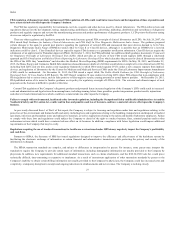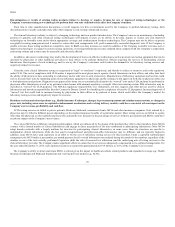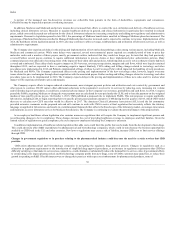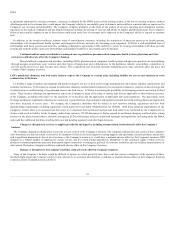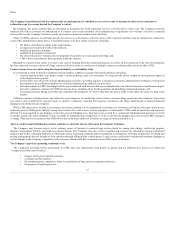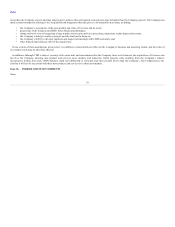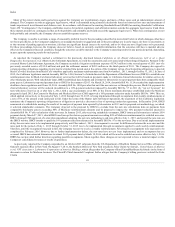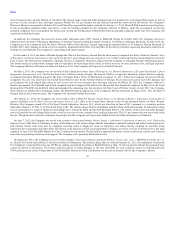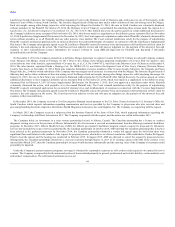LabCorp 2015 Annual Report Download - page 37
Download and view the complete annual report
Please find page 37 of the 2015 LabCorp annual report below. You can navigate through the pages in the report by either clicking on the pages listed below, or by using the keyword search tool below to find specific information within the annual report.
Index
Part of the Company's strategy involves deploying capital in investments that enhance the Company's business, which includes pursuing strategic
acquisitions to strengthen the Company's scientific capabilities and enhance therapeutic expertise, enhance esoteric testing and global drug development
capabilities and increase presence in key geographic areas. Since 2010, the Company has invested net cash of approximately $5.8 billion and equity of $1.8
billion in strategic business acquisitions ($2.2 billion over the same period excluding the acquisition of Covance). However, the Company cannot assure that
it will be able to identify acquisition targets that are attractive to the Company or that are of a large enough size to have a meaningful impact on the
Company's operating results. Furthermore, the successful closing and integration of a strategic acquisition entails numerous risks, including, among others:
• failure to obtain regulatory clearance, including due to antitrust concerns;
• loss of key customers or employees;
• difficulty in consolidating redundant facilities and infrastructure and in standardizing information and other systems;
• unidentified regulatory problems;
• failure to maintain the quality of services that such companies have historically provided;
• coordination of geographically-separated facilities and workforces; and
• diversion of management's attention from the day-to-day business of the Company.
The Company cannot assure that current or future acquisitions, if any, or any related integration efforts will be successful, or that the Company's business
will not be adversely affected by any future acquisitions, including with respect to net revenues and profitability. Even if the Company is able to successfully
integrate the operations of businesses that it may acquire in the future, the Company may not be able to realize the benefits that it expects from such
acquisitions.
At December 31, 2015, indebtedness on the Company's outstanding Senior Notes totaled approximately $5,525.0 million in aggregate principal. The
Company is also a party to credit agreements relating to a $1.0 billion revolving credit facility and a term loan with a principal balance of $715.0 million as
of December 31, 2015. Under the term loan facility and the revolving credit facility, the Company is subject to negative covenants limiting subsidiary
indebtedness and certain other covenants typical for investment grade-rated borrowers, and the Company is required to maintain a leverage ratio that declines
over time.
The Company’s increased indebtedness could adversely affect its business. In particular, it could increase the Company’s vulnerability to sustained,
adverse macroeconomic weakness, limit its ability to obtain further financing and limit its ability to pursue certain operational and strategic opportunities.
The Company may also enter into additional transactions or credit facilities, including other long-term debt, which may increase its indebtedness and
result in additional restrictions upon the business. In addition, major debt rating agencies regularly evaluate the Company's debt based on a number of
factors. There can be no assurance that the Company will be able to maintain its existing debt ratings, and failure to do so could adversely affect the
Company's cost of funds, liquidity and access to capital markets.
If the Company fails to successfully complete the integration of Covance into its existing operations or is not able to achieve the anticipated benefits of the
Acquisition and integration, its business and results of operations could be negatively affected. In addition, it is possible that the ongoing integration process
could result in the loss of key employees, errors or delays in systems implementation, the disruption of the Company’s ongoing business, inconsistencies in
standards, controls, procedures and policies, or disruptions in its relationships with suppliers and other parties with which it deals that could adversely affect
the Company’s ability to maintain relationships with customers and employees or to achieve the anticipated benefits of the acquisition. Integration efforts
could also place a significant burden on the Company's management, employees and internal resources, which could otherwise have been devoted to other
business opportunities and improvements.
The ongoing success of the transaction will depend, in significant part, on the Company’s ability to realize the anticipated benefits from the acquisition,
including the opportunity for revenue growth in development and commercialization of drugs and diagnostics, nutritional analysis and other areas, including
a number of new business areas for the Company. Actual revenue growth may be
37


